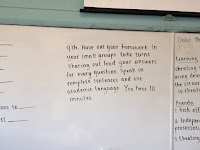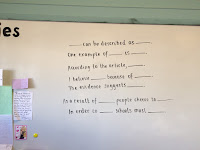Teacher Appreciation Week
Berkeley High School is fortunate to have an amazingly talented staff. Below is a sampling of teachers who have been acknowledged by their teacher leaders and administrators for their hard work, creativity, and dedication to their craft and their students.
Please add to the list in the comments section below.
Molly Lawerence
Tamara Friedman: "Molly goes above and beyond to engage and support her students. As students walk into her classroom they are immediately welcomed by her ever-present smile and warm personality. She engages her students through cultural projects including dance lessons, creating altars, and music. She works long beyond her work day tutoring and supporting individual students. We are lucky to have her."
Amanda Levin
Mat Glaser: "Amanda jumped into her first year of crazy AHA life and hit the ground running-field trips, inter-disciplinary projects, and incredibly rigorous and inspiring teaching."
Lauren Benjamin
Mat Glaser: "Lauren puts the funky-fresh in our AHA world. Its only her second year and it seems like she has been here since the beginning-dancing, drawing, musical theater, karaoke- she has got it all!"
John Tobias
Allen Boltz: "John is always there to help anytime, despite the fact that he teaches 6-8th periods. He is always present at PD meetings and willing to take on extra tasks to support students."
Kate Trimlett
Andy Peck: "For her tireless advocacy of the 4R's and hands-on environmental science instruction. Her students are constantly engaged and active participants in their own learning. And for her consistently enthusiastic and supportive work with her colleagues."
Colleen Simon O'Neil
Glenn Wolkenfeld: "For her fabulous work in Anatomy and Physiology."
Allen Boltz
Glen Wolkenfeld: "For his great work bridging different philosophies on the chemistry team to support our goal of a common assessment."
Nicole Nagappan
Angie Dean: "Nicole is above and beyond dedicated to her students. She follows up with them in later years, always continually coaching, motivating, and advocating for their overall success as productive human beings, not just as students."
Amanda Green
Angie Dean: "Amanda's dedication to growth, both her own and her students', is amazing and enviable."
Andy Waranoff
Amy Burke: "Andy is an exceptional teacher who forms strong relationships with students and staff. His classroom is relaxed but focused, he creates content, supports daily, and shares them with grateful colleagues!"
Dave Goodrich
Amy Burke: "Dave is a foundational member of our staff. In creating, organizing, and sharing his thoughtful lessons, students across the school benefit. His calm and focused demeanor in the classroom is a model I aspire to replicate. Thank you Dave!"
Cathy Dao
Matt Meyer: "Cathy is a dedicated teacher who always puts students first. She organized multiple field trips for our BIHS 10th graders and even volunteered to organize a field trip for students she does not currently teach."
Elieen Jacobs
Susannah Bell: "Eileen has an extraordinary way of relating to students and holding students to a high standard. I have learned so much from her."
Rolando Morales
Susannah Bell: "Rolando works a certain magic with a group of our kids who need a lot of love and support. I have seen him in action and he is brilliant!"
Kate Newton
David Stevens: "Kate transcends the traditional role of Speech Pathologist and finds ways to work with her students in their regular lives. From joining them in their classes to helping supervise field trips Kate takes advantage of every opportunity to find ways to help her students grow."
Amy Crawford
Leah Katz: "Amy has so many tricks up her sleeve that students can reveal any interest, question, or writing challenge and she knows how to address it with humor, integrity, and love."
Kate Garfinkel
Leah Katz: "Dr. G manages to get to every group, every student, and every raised hand as if by magic. Students flood her room after school for the help that she provides patiently, ever so patiently."
Lauren Lovett
Diane Colborn: "Lauren works tirelessly and creatively to foster the inclusion of her students with learning and behavior differences in all aspects of high school culture. She deserves special recognition for giving of her own time to organize a cooking club and social skills group."
Audrey Portley Bernstein
Rachel CR: "Audrey goes way out of her way to support students, spending extra hours in their classes, designing academic supports, and helping students to believe in themselves."
Heidi Ramirez-Weber
Dave Stevens: "Heidi is a tireless defender/supporter of those in need. Whether it be her Newcomer students, LTELs, students with disabilities, or a struggling teacher, Heidi always sees crisis as opportunity and can always be counted on for a thoughtful response."
Jenny Roebuck
Matt Carton: "Jenny came in under hard circumstances- she had to replace a legend, Tim Moellering. She has embraced what Berkeley High is about. Its always great to see a young teacher who "gets it"."
Matt Laurel
Matt Carton: "Oh to be young again. Matt Laurel is as good an English teacher as I have ever worked with. And to think he was born the year David Bye began at BHS..."
Kate Haber
Evy Kaveler: "Kate goes above and beyond what most teachers do. She helps out new teachers as well as veteran teachers in ways that would amaze you. Thanks Kate!"
Sam Rozen
Evy Kaveler: "Sam is a favorite among chemistry students. His daily welcome is repeated daily by both teacher and his students."
Lauren Benjamin
Shannon Erby: "Lauren Benjamin has inspired the creativity in students in both visual and performing arts. She has also successfully worked with a student with autism, supporting him to perform in front of his peers."
Amanda Levin
Shannon Erby: "Amanda has had success with students who have typically only known academic failure. She is a patient and skilled teacher."
Marcela Taylor
Heidi Ramirez-Weber: "As a master Spanish Teacher, she has taken on the new challenge of teaching ELD4 this year. She is also an immigrant who went through the BHS ELD Program for a few years and then mainstreamed into the big school. Besides being an excellent language teacher, she is a role model for her EL students and teaches about culture, acculturation, and immigrant experiences. Moreover, she constantly challenges her ELS to improve their critical thinking and problem solving skills."
Christina Mitchell
Heidi Ramirez-Weber: "Christina teaches SDAIE World Literature this year and as a new teacher of all English Learners she has become excellent at teaching language to ELs by directly teaching vocabulary, facilitating structured language practice like "give one get one for lines of communication", and writing objectives with academic language that can be assessed during or at the end of the class in an exit slip or exit ticket."
Angela Dean, Matt Carton, Gideon Goldman, Jordana Anderson
Daniel Roose: "Consistently reliable with attendance records, daily attendance, paper audits, and field trips. Thank you!"







